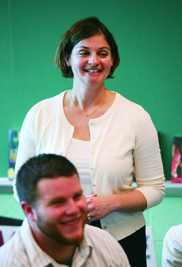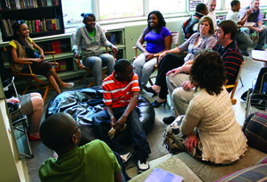Featured Article
Learning Connections Teach Future Teachers to Integrate Subject Areas at Kent State University at Stark
Future teachers are now learning to work together to help young students recognize and understand the many connections between subjects.
read moreLearning Connections Teach Future Teachers to Integrate Subject Areas at Kent State University at Stark
Posted Nov. 15, 2010An overview of 20th-century European history.
Introductory lessons on physics and algebra.
What do these three things have in common? A student majoring in middle childhood education (MCED) at Kent State University at Stark would say, "Everything."

Lori Wilfong
She says, "We all learn better when we see how concepts relate to one another. At Kent State Stark, our MCED students are trained in a variety of practical methods that concentrate on child development and individual learning processes along the focus of elementary education while delivering integrated, foundational content for children ages eight to 14."
Out of the ivory tower
Students entered upper-level MCED courses in 2000, making it the first education degree program offered in its entirety at Kent State Stark. Currently, each cohort includes approximately 20 undergraduates and, according to Wilfong, the pipeline continues to grow. To meet increasing demand, Kent State Stark has added more introductory education sections, which also helps those who are majoring in early childhood and secondary education but must complete their degrees at the Kent Campus.
Dr. Claudia Khourey-Bowers, associate professor of education and coordinator of graduate education, notes that the MCED program at Kent State University, as a whole, and Kent State Stark, in particular, possesses a strong reputation for high-quality teacher preparation that reaches well beyond Northeast Ohio.
"Our faculty members are not locked in the ivory tower," says Khourey-Bowers. "Rather, they are very active in area schools as consultants. And, we set the bar high for our students, who must complete more than 120 hours of field experience prior to student teaching which greatly exceeds the state minimum. The more time they spend in the classroom, the better they understand its complexities."
Most Kent State Stark MCED students complete their field experiences in Canton City Schools, Northwest Local Schools or Plain Local Schools. Through Kent State's reciprocity with districts in Florida, North Carolina and Texas, students may also choose study-away experiences.Workplace connections
Kent State Stark strives to prepare its students for success. All MCED graduates are qualified to teach in at least two of the four areas of concentration, as well as reading for grades four through nine. Many pursue the generalist license (which includes all four concentrations) and/or a K-12 reading endorsement to improve their marketability.
Networking with education professionals and administrators is encouraged through field experience, professional conferences, tutoring and other education-related services. And, those who join Kent State Stark's Education Association, an affiliate of the Ohio Education Association, gain additional networking opportunities and even participate in mock interviews.
Most years since the program's inception, 70 percent obtain a teaching position within two years of graduation, says Wilfong.
Master's Program a Community of Colleagues
In 2006, Kent State Stark added a 32-hour master's degree program in curriculum and instruction, a logical progression in Ohio where instructors are required to earn a graduate degree within five years of their entrance into the teaching profession.
"One of the best things about our master's program which normally has between 40 and 50 students in any given semester is its flexibility," says Khourey-Bowers.
Geared for licensed teachers who want to improve their skills and become leaders in curriculum development, 16 course hours are required and the other 16 are elective. With no cohorts, students can take classes when they need to, normally earning their master's within two and a half years. And, they are able to roll additional teaching endorsements into the degree and personalize projects by areas of specialty or interest.Khourey-Bowers notes that teachers come to the Kent State Stark to get a degree and end up discovering a community of colleagues. No matter how late classes run, many stay after and talk because they discover real camaraderie. They can share their hopes, dreams and frustrations with others who love teaching, she says.
(This article first appeared in the fall 2010 issue of Encompass.)
